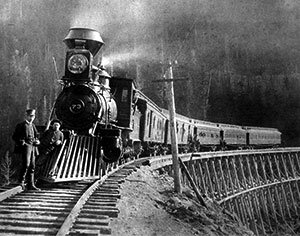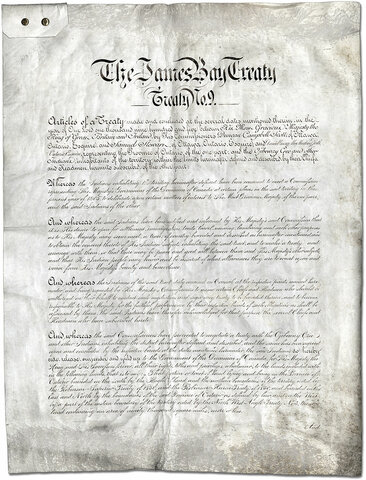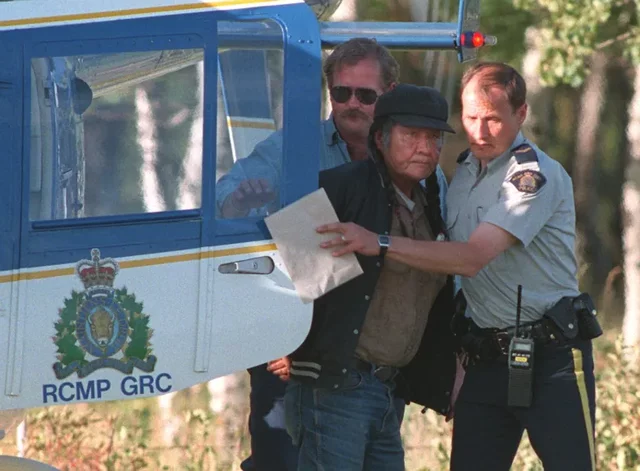-
 In the early 1760's, British commander Sir Jeffery Amherst discussed the use of trading blankets and linen infected with the smallpox virus with the native people as a way to "reduce" them.
In the early 1760's, British commander Sir Jeffery Amherst discussed the use of trading blankets and linen infected with the smallpox virus with the native people as a way to "reduce" them.
There are very little examples of colonists using blankets infected with smallpox to infect the native people, and accounts from tribes are even harder to find. -
The Royal Proclamation of 1763 was a way to establish the basis of governing North American countries that had been surrendered by France and Britain. Its policies were meant to assimilate French people to British rule. The Royal Proclamation is also known as an “Indian Bill of Rights” as it also set the constitutional structure for the negotiation of treaties involving Indigenous peoples in large sections of Canada. The Proclamation ultimately failed and was replaced in 1774 by the Quebec act.
-
The Quebec act was put into place as a way to gain loyalty from French-speaking citizens of Quebec by restoring their property rights and freedom of worship. However, this act was not recieved well by everyone. It is considered one of five "Intolerable acts" by The Thirteen American Colonies and it was a direct cause of the American Revolutionary war.
-
 This war was started by Great Britain adopting measures as a result of the Napoleonic Wars that upset the United States. The United States allied with indigenous people while the United Kingdom allied with British North America. The war would go on until terms of peace were agreed on in the Treaty of Ghent 1814. However the war didn't truly end until 1815 when the treaty was signed by congress.
This war was started by Great Britain adopting measures as a result of the Napoleonic Wars that upset the United States. The United States allied with indigenous people while the United Kingdom allied with British North America. The war would go on until terms of peace were agreed on in the Treaty of Ghent 1814. However the war didn't truly end until 1815 when the treaty was signed by congress. -
The constitution act is a very important document to Canada's history as it allowed Canada to achieve full indepencence from Britain. It no longer needed approval from Britain to change its constitution.
In 1984, PM Brian Mulroney was determind to amend the constitution so it would be accepted into the government of Quebec. This ended up falling through when the legislatures of Newfoundland and Manitoba failed to sign the agreement. -
The Indian Act is a law the government used to enforce the Indian status on first nations and indogenous peoples. It also enforced governmental obligations and stripped them of thier rights. Those who were of Indian status were banned by law from practicing their culture.
Over the years it has been amended time and time again in attempts to remove any discriminatory parts. -
 The Canadian Pacific Railway was founded in 1881. The government needed to secure land on the praries so Canada could survive as a nation. They arranged a series of treaties with the First Nations living on the praries. These treaties are known as The Numbered Treaties. When it was first founded, the CPR did not have enough money nor workers. These problems were solved by the government provided millions of dollars and the second was solved by employing over 15,000 Chinese workers.
The Canadian Pacific Railway was founded in 1881. The government needed to secure land on the praries so Canada could survive as a nation. They arranged a series of treaties with the First Nations living on the praries. These treaties are known as The Numbered Treaties. When it was first founded, the CPR did not have enough money nor workers. These problems were solved by the government provided millions of dollars and the second was solved by employing over 15,000 Chinese workers. -
 Louis Riel was the leader of the Métis and a significant figure within the Red River and North-west resistances. In 1885 he was found guilty of high treason for resisting encroachment on Métis land and was executed by hanging. Initially viewed as a rebel, he is now honored by many as a hero who fought for his people.
Louis Riel was the leader of the Métis and a significant figure within the Red River and North-west resistances. In 1885 he was found guilty of high treason for resisting encroachment on Métis land and was executed by hanging. Initially viewed as a rebel, he is now honored by many as a hero who fought for his people. -
Key places and events for the gold rush in Canada were: The Fraser River, Cariboo gold rush, and the Klondike gold rush. The production of gold around the world had little to no impact on Canada however, the pursuement of it led to many indigenous communities being displaced and marginalized by the prospectors.
-
During the operation of residential schools in Canada, many indigenous girls underwent forced sterilization. More often than not, these surguries were done without consent of the child and were passed off as different reasons. Many did not know this had happened to them until years later in their lives. Alberta had a Sexual Sterilization Act that was in place for almost 50 years and was removed in 1972. During all of this, over 2800 prodecures were done.
-
 The James Bay treaty is the 9th of the Numbered Treaties and it had been formed from one of the many negotiations between indigeous people and Canada. The treaties purpose was to purchase interests from the Cree and Ojibwe people to make way for the settlement of white people. The treaty also contained provisions for fishing and trapping rights, treaty payments, reserves and education.
The James Bay treaty is the 9th of the Numbered Treaties and it had been formed from one of the many negotiations between indigeous people and Canada. The treaties purpose was to purchase interests from the Cree and Ojibwe people to make way for the settlement of white people. The treaty also contained provisions for fishing and trapping rights, treaty payments, reserves and education. -
 The Gustafen Lake standoff was a conflict between First Nations Sun Dancers and the RCMP that lasted for a month. The conflict started with a rancher and a few sun dancers over access to private land for cerimonial purposes. The RCMP were called and they surrounded the Sun Dancers while armed. During this conflict, a firefight broke out, two Ts'Peten defenders drove over an explosive planted by the RCMP and a non indigenous activist was shot in the arm.
The Gustafen Lake standoff was a conflict between First Nations Sun Dancers and the RCMP that lasted for a month. The conflict started with a rancher and a few sun dancers over access to private land for cerimonial purposes. The RCMP were called and they surrounded the Sun Dancers while armed. During this conflict, a firefight broke out, two Ts'Peten defenders drove over an explosive planted by the RCMP and a non indigenous activist was shot in the arm.